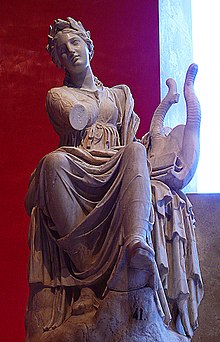| Terpsichore | |
|---|---|
Goddess of Dancing and Chorus | |
| Member of the Muses | |
 | |
| Abode | Mount Olympus |
| Symbols | Lyre |
| Personal information | |
| Parents | Zeus and Mnemosyne |
| Siblings | Euterpe, Polyhymnia, Urania, Clio, Erato, Thalia, Calliope, Melpomene and several paternal half-siblings |
| Consort | Apollo, Achelous, Ares |
| Children | Linus, Biston, the Sirens |

In Greek mythology, Terpsichore ( /tərpˈsɪkəriː/; Greek: Τερψιχόρη, "delight in dancing") is one of the nine Muses and goddess of dance and chorus. She lends her name to the word " terpsichorean", which means "of or relating to dance".
Appearance
Terpsichore is usually depicted sitting down, holding a lyre, accompanying the dancers' choirs with her music. Her name comes from the Greek words τέρπω ("delight") and χoρός ("dance").
Family
According to Hesiod's Theogony, Zeus lay with the Titan Mnemosyne each night for nine nights in Piera, producing the nine Muses. [1]
According to Apollonius of Rhodes, Terpsichore was the mother of the Sirens by the river god Achelous. [2] The Etymologicum Magnum mentions her as the mother of the Thracian king Biston by Ares. [3] According to the Byzantine scholar Eustathius, Terpsichore was the mother of the Thracian king Rhesus by the river god Strymon. [4]
In popular culture

Historical
- The British 32-gun frigate HMS Terpsichore (1785) commanded by Captain Bowen participated in the Battle of Santa Cruz de Tenerife (1797).
Literature
- When The Histories of Herodotus were divided by later editors into nine books, each book was named after a Muse. Terpsichore was the name of the fifth book.
Music and dance
- Terpsichore (1612) is the title of a large collection of dance tunes collected by Michael Praetorius, some originating with Pierre-Francisque Caroubel and some later adapted for wind ensemble by Bob Margolis.
- Terpsichore is also found in François Couperin's "Second Ordre" from the Pièces de clavecin.
- The third version (HWV 8c) of Handel's opera Il pastor fido (1712) includes a new prologue written in 1734 titled Terpsicore.
- The eighteenth century French dancer and courtesan Marie-Madeleine Guimard named the private theater in her private palace (1766) the Temple of Terpsichore.
- George Balanchine's 1928 ballet Apollo (ballet) includes Terpsichore as one of 3 muses who dance to win the hand of Apollo.
- Terpischore appears in the 1980 musical film Xanadu but uses the name Kira until near the end. She was portrayed by Olivia Newton-John.
Media
- In the 1947 film Down To Earth, Rita Hayworth plays Terpsichore, who is annoyed and visits Earth to change a musical that depicts her in a bad light. [5]
Science
- Terpsichore, a genus of ferns in the family Polypodiaceae, subfamily Grammitidoideae named after the Muse [6]
- The terpsitone, an electronic musical instrument invented by Leon Theremin, was named after Terpsichore. [7]
- The asteroid 81 Terpsichore
See also
Notes
- ^ Gantz, p. 54; Hesiod, Theogony 53–62, 915–7.
- ^ Apollonius of Rhodes, Argonautica 4.893 (pp. 354, 355); so too Nonnus, Dionysiaca 13.313–5 (pp. 452, 453); Tzetzes, Chiliades, 1.14, line 338 & 348.
- ^ Etymologicum Magnum, 197.59 (p. 179).
- ^ Eustathius on Homer, Iliad p. 817.[ verification needed]
- ^ "New Flower Named For Rita Hayworth". Pittsburgh Post-Gazette. Pittsburgh, Pennsylvania. August 29, 1946. p. 15. Retrieved May 2, 2016.
- ^ Smith, Alan R. (1993). "Terpsichore, a New Genus of Grammitidaceae (Pteridophyta)". Novon. 3 (4): 478–489. doi: 10.2307/3391398. JSTOR 3391398.
- ^ Mason, C. P. (1936). Theremin "Terpsitone" A New Electronic Novelty in Radio Craft, Dec. 1936, p.365.
References
- Apollonius of Rhodes, Apollonius Rhodius: the Argonautica, translated by Robert Cooper Seaton, W. Heinemann, 1912. Internet Archive.
- Etymologicum Magnum, edited by Friderici Sylburgii, Leipzig, J. A. G. Weigel, 1816. Internet Archive.
- Gantz, Timothy, Early Greek Myth: A Guide to Literary and Artistic Sources, Johns Hopkins University Press, 1996, Two volumes: ISBN 978-0-8018-5360-9 (Vol. 1), ISBN 978-0-8018-5362-3 (Vol. 2).
- Hesiod, Theogony, in The Homeric Hymns and Homerica with an English Translation by Hugh G. Evelyn-White, Cambridge, Massachusetts, Harvard University Press; London, William Heinemann Ltd., 1914. Online version at the Perseus Digital Library. Internet Archive.
External links
-
 Media related to
Terpsichore at Wikimedia Commons
Media related to
Terpsichore at Wikimedia Commons - Warburg Institute Iconographic Database